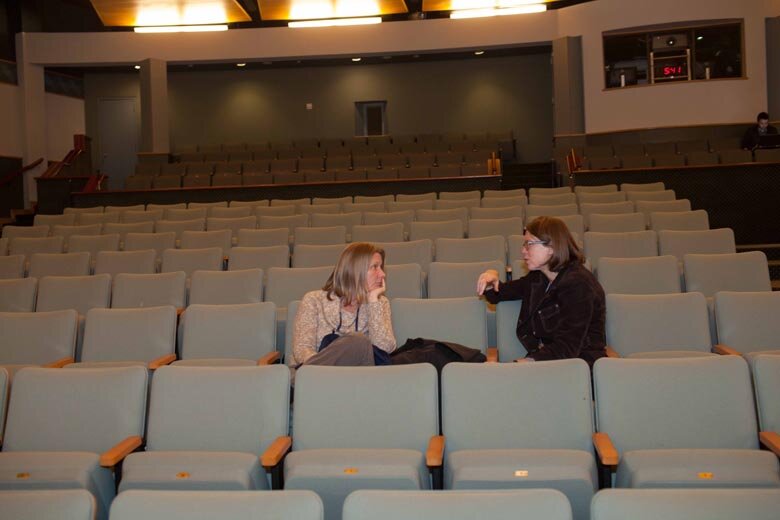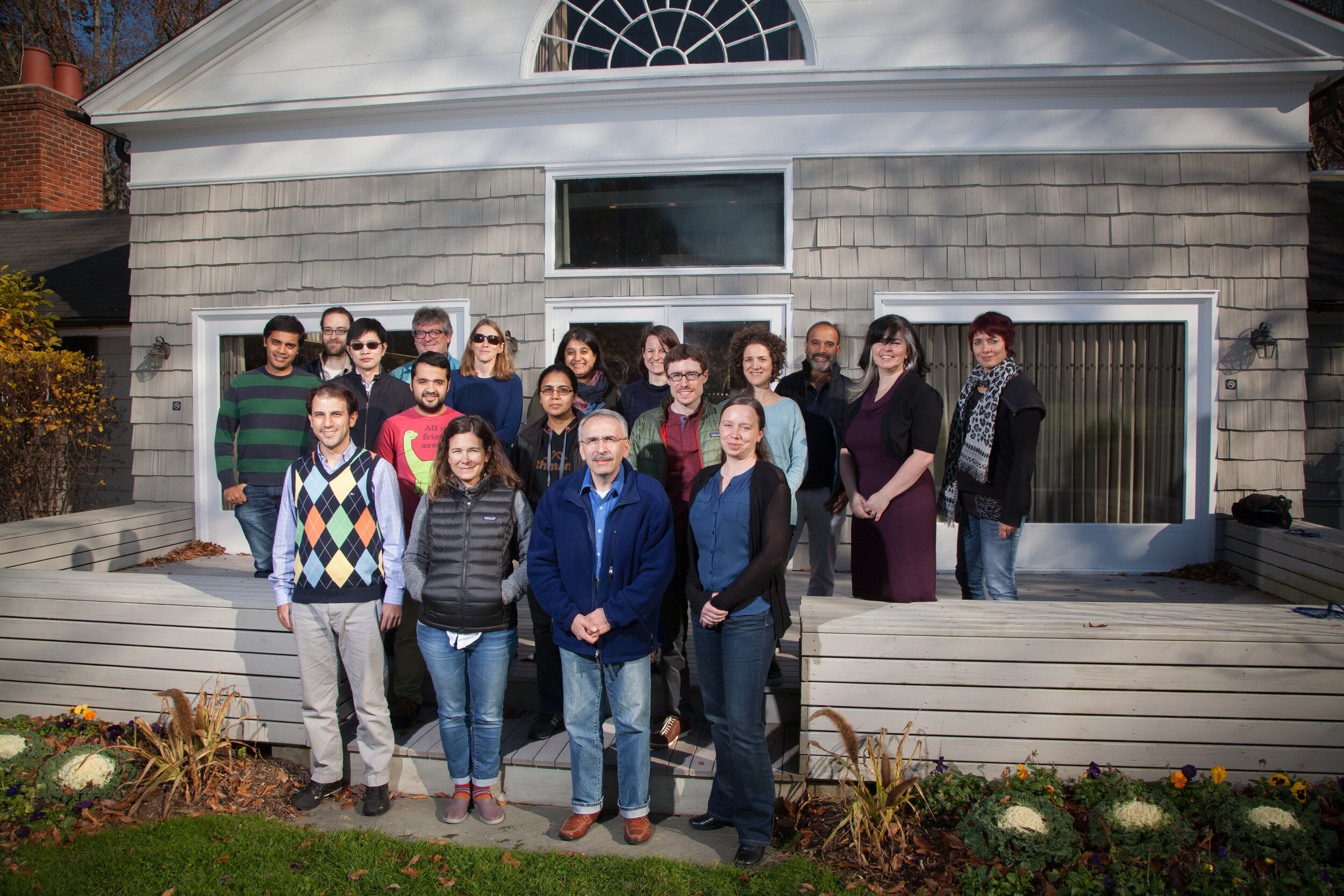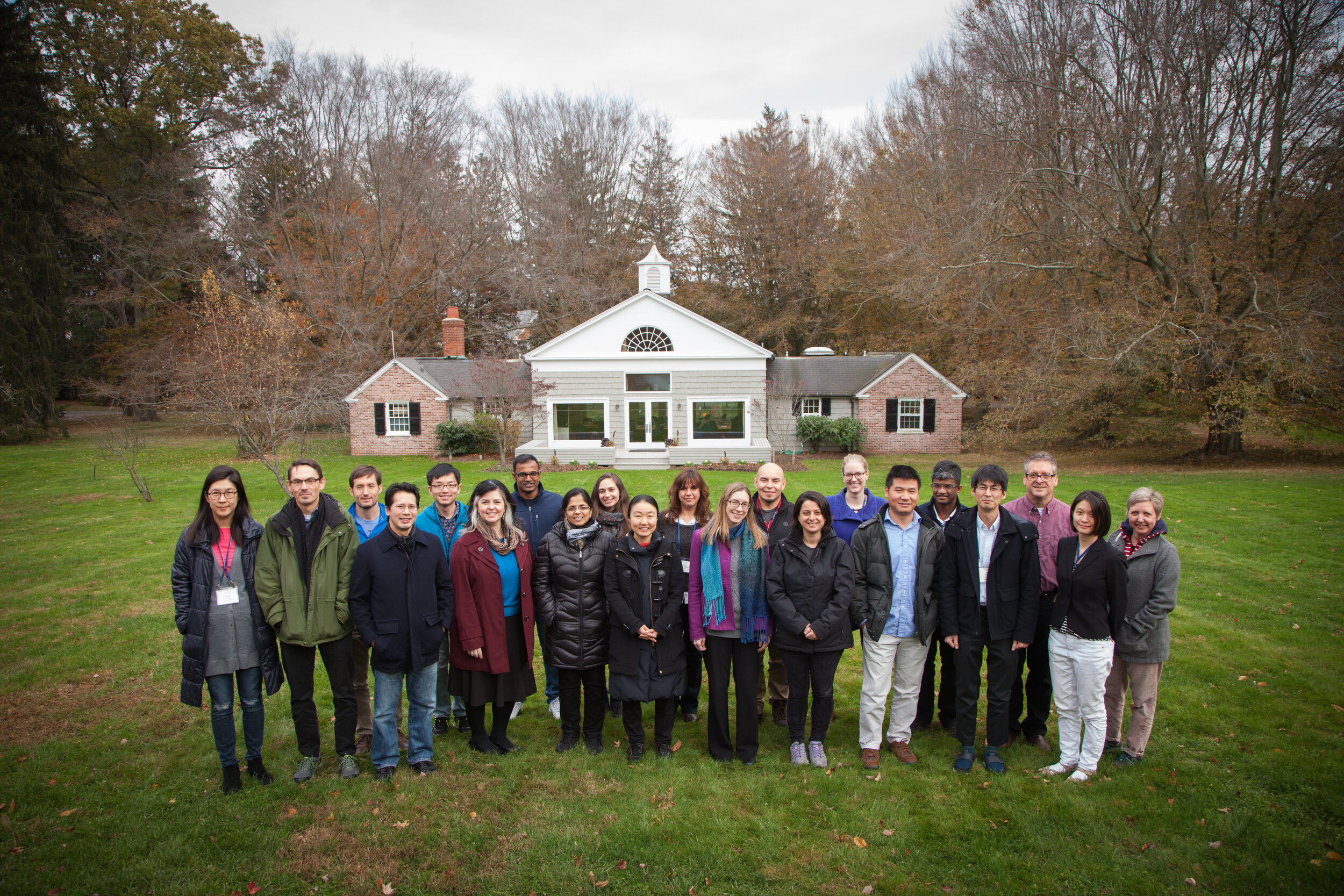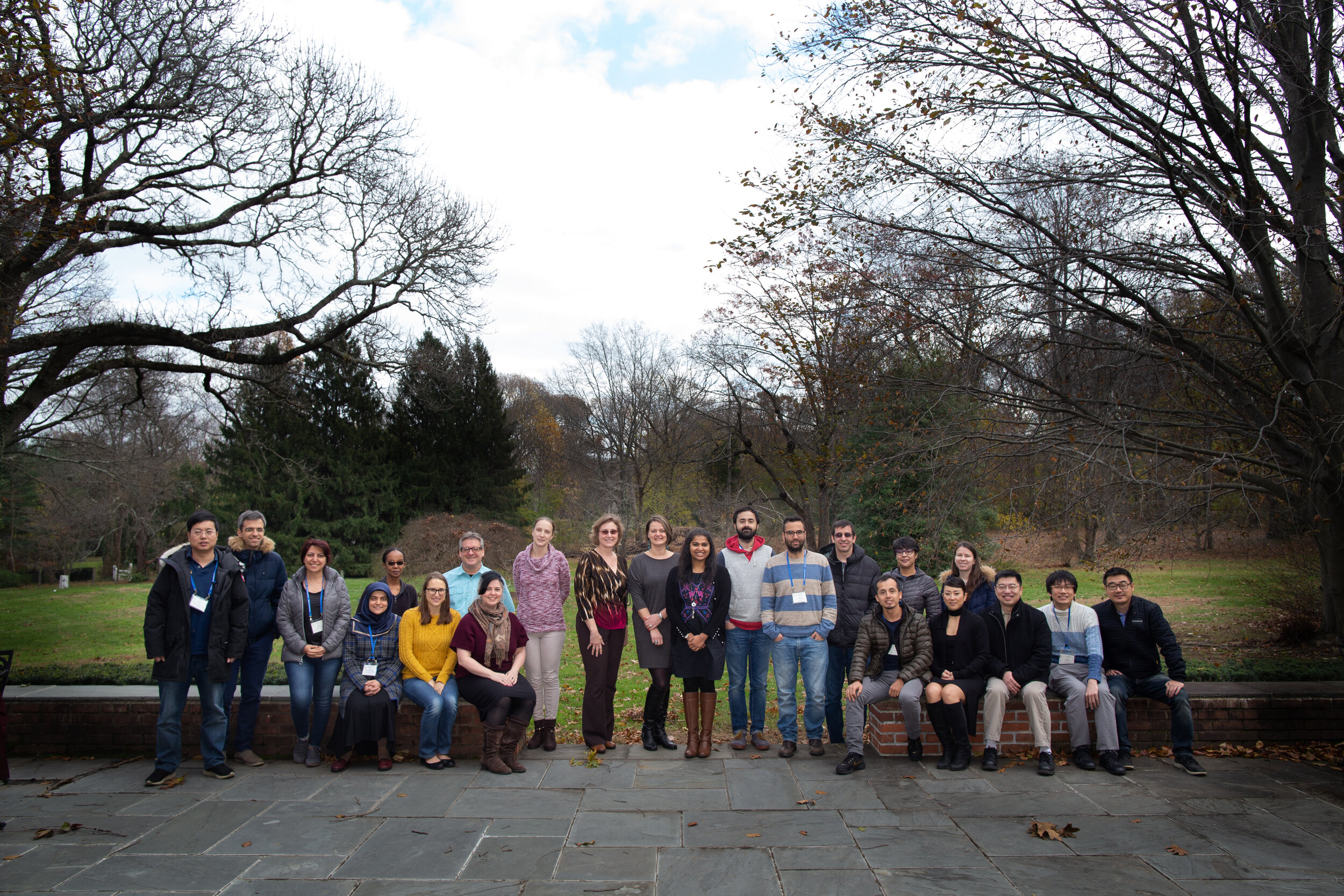Pre-banquet cocktail hour during the Biology & Genomics Social Insects meeting in 2018.
In March 2021, researchers of the social insect community again convened at Cold Spring Harbor Laboratory (CSHL) for the third meeting on Biology & Genomics of Social Insects—albeit virtually due to the covid pandemic. The online format did not deter these scientists from presenting and discussing the latest developments in their field. On the contrary, the number of participants this year more than doubled compared to the last iteration in 2018, and 92% of the 232 registered participants joined the lively meeting discussions on exchanging a whopping 4,462 messages and 113 files via the platform during the meeting’s 3 days!
First held in 2007, this meeting was called ‘Honey Bee Genomics & Biology Workshop’ until 2015 when it underwent a name change to reflect progress in the wider field of genomics. We asked 2021 Meeting Co-organizers Sandra Rehan, Olav Rueppell and Seirian Sumner to talk us through the renaming as it relates to the evolution of their field, as well as the effects the name change may have had on the meeting itself.
Sandra: The first iteration of this meeting in 2007 was originally titled “Honey Bee Genomics” to coordinate efforts for the honey bee genome that had just been published in 2006.
Olav: The Western honey bee (Apis mellifera) was one of very few Metazoan genomes available in 2006 so the focus of the first meeting was justifiably on that one particular species. A lot of those early studies created excitement because they were performed on a social insect for the very first time. But we have made a lot of progress since then that has broadened the taxonomic focus and the questions that we can ask.
Sandra Rehan with Amro Zayed on the Nichols Biondi Hall Patio.
Sandra: Quickly thereafter, the ant and termite community started sequencing genomes and many more wasp and bee genomes became available; currently we are up to 53 bee genomes and nearly 100 ant genomes. The field exploded over the past 15 years with hundreds of researchers around the world working on social insect genomics. I have attended the past three CSHL meetings and I’ve noticed a pleasant shift in taxonomic diversity recently, especially in this year’s meeting, to reflect the reality of our research community and range of research organisms.
Seirian: As a non-honeybee researcher, I recall being very much a minority at the 2007 meeting. I came with my poster on Polistes gene expression, and I remember being in awe of the incredible progress honeybee researchers had made. Over the years, the huge progress made in honeybee genomics laid the path for genomic analyses of other social insects and, as Sandra and Olav mentioned, the focus has now shifted to be about social insects in general. Our meeting this year included talks and posters on the full spectrum of social insects, including bees (not just honeybees), ants, wasps and termites. Today, the only thing that stands in the way of genomic analyses of a species is getting high-quality DNA/RNA (and the small matter of funding to sequence it!).
Olav: It is not only the sheer number of available genomes, but also the availability of accessible analysis tools and broadly applicable functional tools that has revolutionized the field. As organizers, we ensured that the taxonomic diversity in the program reflected this trend. The name change reflects a categorial switch, but underlying that is the continuous progress of our scientific community.
The social insect community typically meets at CSHL every 3-4 years, but does it get together somewhere else during the “off” years?
Seirian: Yes, of course. There are several other societies that run conferences; of most relevance is the International Union for the Study of Social Insects (IUSSI).
Sandra: We meet at the international IUSSI meetings every 4 years, and the IUSSI also holds regional meetings around the world every two years. In North America, many of our researchers also meet at the annual Entomological Society of America meetings as well as the quadrennial International Congress of Entomology (ICE) meetings.
Seirian: The CSHL meeting is always carefully timed to fall in the in-between years.
What sets your CSHL meeting apart from the IUSSI meeting?
Olav Rueppell interacting with a poster presenter during the 2018 Biology & Genomics of Social Insects’ poster session.
Sandra: The meetings I mentioned include genomics but typically also focus on the behavior, ecology and evolution, as well as applied questions in our field.
Seirian: To add to that, the meeting at CSHL has a specific focus on genomics that is useful for a more specialist audience as talks and posters can dive in deeper and more quickly.
Olav: In addition to being very thematically focused, this meeting is quite unique because it emphasizes unpublished cutting-edge results and is restricted to one session (meaning it does not have parallel sessions).
Sandra: This meeting is typically small and intimate, and the on-site housing makes for a wonderful networking experience.
Olav: The intimate size is great at encouraging conversations.
Meetings at CSHL are indeed well-known for their intimate size. But are there groups not attending this meeting that could benefit from participating?
Seirian: By being at CSHL, these meetings possibly fall off the radar for people who study social insects from the more ecological (non-molecular) perspective. And this is a shame as attending these meetings is a great way to learn about the exploding field of genomics and can take our study of social insect biology to a new level. So, whilst it is a very popular meeting among those who already work on the genes side of social insects, I think it's a very valuable opportunity for others; especially early career researchers who may like to broaden their approaches.
Sandra: New early career investigators would find this meeting very useful for networking and career development. It also provides insights into new and emerging questions in the field, which is wonderful for shaping future research directions and collaborations.
Olav: The opportunity to network in a great environment, plus the high quality of talks and focus on innovative studies make this an attractive meeting for everyone. So, in my view, everyone interested in understanding the biology of social insects--particularly from a genomics perspective--would benefit from this meeting.
Seirian Sumner checking out the posters in Nichols Biondi Hall.
Was there a scientific development presented at this year’s meeting you are most excited about?
Olav: The broad comparative analyses of many genomes to understand social evolution and the reports on single-cell sequencing that allow an unprecedented resolution of our functional genomic studies were two developments that I found very exciting.
Sandra: Yes, the use of single cell RNAseq (scRNA-seq) across honey bees, paper wasps and ants was exciting to see. This is a relatively new technology to our community and it’s being implemented in leading labs across North America and Europe.
Thinking back on all the years you’ve attended this meeting, what is your favorite memory of it?
Sandra: The closing banquet and daily mixer sessions are my favorite parts of this meeting. CSHL is such a uniquely tranquil place to talk science while overlooking the water on the open lawn. Three years ago, I remember sitting on picnic tables to discuss new ideas and form international collaborations that have since resulted in major research funding, a review paper this year, and ongoing working relationships.
Seirian: Lobster. I'd never had a whole lobster before the 2015 meeting and a grant was hatched over those lobsters that ended up being funded! I recommend eating to get the creative juices going.
It’s safe to say that we all prefer in-person meetings but was there an aspect of the virtual format that you liked? What portion(s) of the meeting were enhanced by the virtual format?
Seirian: Personally, I can't wait for face-to-face meetings to resume. What I love about conferences are the chats outside of the talks, getting to know the people whose papers I've read, and making new friends with a shared love of these quirky insects. But equally, the forced move online for conferences is making a huge difference to inclusivity for people around the world especially those who don't have the funds to travel; particularly those in developing countries, and those who have caring commitments that preclude them taking time away from family. The other thing that was fun was the 'online chat' whilst the talks were going on. At an in-person meeting, you can't lean over to a colleague and ask them a question about the talk but when it's online, you can have a running discussion alongside the talks, which can enrich what you get out of it.
Sandra: Slack indeed allowed for ongoing discussions and shared resources not easily possible in an in-person format. It provided a safe space for students and researchers to converse, and ask questions of speakers that they could answer in their own time. Many ongoing and stimulating conversations were new to this meeting thanks to the addition of Slack and I hope it continues.
Olav: I too liked that we were able to have a larger and more diverse group of attendees than in previous years. The relatively high price tag of an in-person meeting made it unintentionally exclusive, which we fortunately were able to overcome this year thanks to the online format. Maybe a hybrid model can be offered in the future to encourage a broader, more diverse and equitable participation.
Thank you to Olav, Sandra and Seirian for “socializing” with us about Biology & Genomics of Social Insects, which returns to CSHL in March 2025. For information on this meeting, be sure to regularly check here.
























